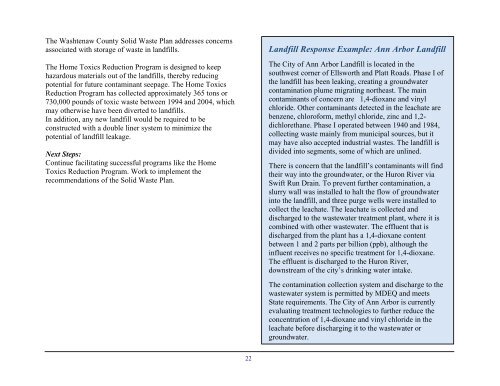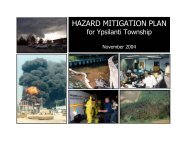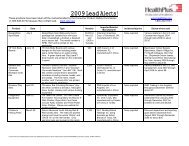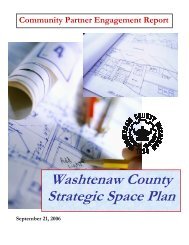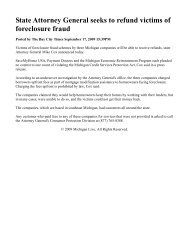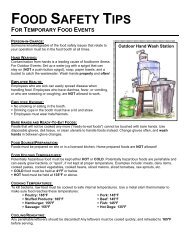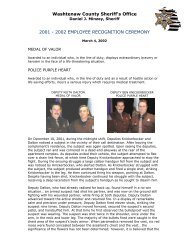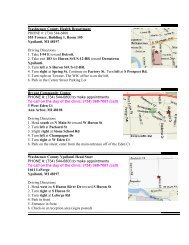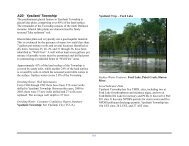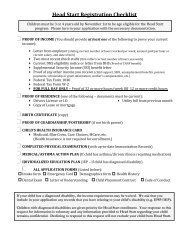Water Protection Activities in Washtenaw County
Water Protection Activities in Washtenaw County
Water Protection Activities in Washtenaw County
Create successful ePaper yourself
Turn your PDF publications into a flip-book with our unique Google optimized e-Paper software.
The <strong>Washtenaw</strong> <strong>County</strong> Solid Waste Plan addresses concerns<br />
associated with storage of waste <strong>in</strong> landfills.<br />
The Home Toxics Reduction Program is designed to keep<br />
hazardous materials out of the landfills, thereby reduc<strong>in</strong>g<br />
potential for future contam<strong>in</strong>ant seepage. The Home Toxics<br />
Reduction Program has collected approximately 365 tons or<br />
730,000 pounds of toxic waste between 1994 and 2004, which<br />
may otherwise have been diverted to landfills.<br />
In addition, any new landfill would be required to be<br />
constructed with a double l<strong>in</strong>er system to m<strong>in</strong>imize the<br />
potential of landfill leakage.<br />
Next Steps:<br />
Cont<strong>in</strong>ue facilitat<strong>in</strong>g successful programs like the Home<br />
Toxics Reduction Program. Work to implement the<br />
recommendations of the Solid Waste Plan.<br />
22<br />
Landfill Response Example: Ann Arbor Landfill<br />
The City of Ann Arbor Landfill is located <strong>in</strong> the<br />
southwest corner of Ellsworth and Platt Roads. Phase I of<br />
the landfill has been leak<strong>in</strong>g, creat<strong>in</strong>g a groundwater<br />
contam<strong>in</strong>ation plume migrat<strong>in</strong>g northeast. The ma<strong>in</strong><br />
contam<strong>in</strong>ants of concern are 1,4-dioxane and v<strong>in</strong>yl<br />
chloride. Other contam<strong>in</strong>ants detected <strong>in</strong> the leachate are<br />
benzene, chloroform, methyl chloride, z<strong>in</strong>c and 1,2dichlorethane.<br />
Phase I operated between 1940 and 1984,<br />
collect<strong>in</strong>g waste ma<strong>in</strong>ly from municipal sources, but it<br />
may have also accepted <strong>in</strong>dustrial wastes. The landfill is<br />
divided <strong>in</strong>to segments, some of which are unl<strong>in</strong>ed.<br />
There is concern that the landfill’s contam<strong>in</strong>ants will f<strong>in</strong>d<br />
their way <strong>in</strong>to the groundwater, or the Huron River via<br />
Swift Run Dra<strong>in</strong>. To prevent further contam<strong>in</strong>ation, a<br />
slurry wall was <strong>in</strong>stalled to halt the flow of groundwater<br />
<strong>in</strong>to the landfill, and three purge wells were <strong>in</strong>stalled to<br />
collect the leachate. The leachate is collected and<br />
discharged to the wastewater treatment plant, where it is<br />
comb<strong>in</strong>ed with other wastewater. The effluent that is<br />
discharged from the plant has a 1,4-dioxane content<br />
between 1 and 2 parts per billion (ppb), although the<br />
<strong>in</strong>fluent receives no specific treatment for 1,4-dioxane.<br />
The effluent is discharged to the Huron River,<br />
downstream of the city’s dr<strong>in</strong>k<strong>in</strong>g water <strong>in</strong>take.<br />
The contam<strong>in</strong>ation collection system and discharge to the<br />
wastewater system is permitted by MDEQ and meets<br />
State requirements. The City of Ann Arbor is currently<br />
evaluat<strong>in</strong>g treatment technologies to further reduce the<br />
concentration of 1,4-dioxane and v<strong>in</strong>yl chloride <strong>in</strong> the<br />
leachate before discharg<strong>in</strong>g it to the wastewater or<br />
groundwater.


